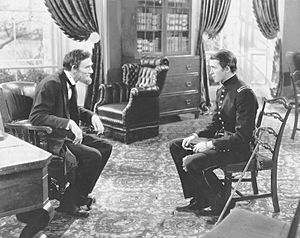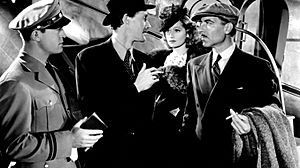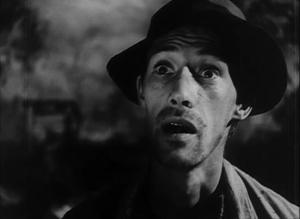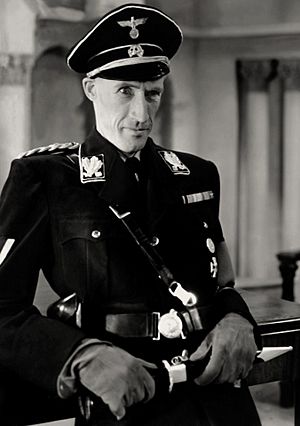John Carradine facts for kids
Quick facts for kids
John Carradine
|
|
|---|---|
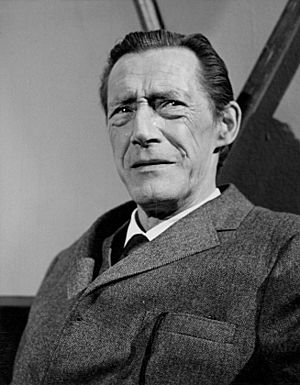
Carradine in a 1967 publicity photo
|
|
| Born |
Richmond Reed Carradine
February 5, 1906 New York City, U.S.
|
| Died | November 27, 1988 (aged 82) Milan, Italy
|
| Other names | Peter Richmond |
| Occupation | Actor |
| Years active | 1930–1988 |
| Spouse(s) |
Ardanelle McCool Cosner
(m. 1935; div. 1944)Sonia Sorel
(m. 1944; div. 1956)Doris Rich
(m. 1957; died 1971)Emily Cisneros
(m. 1975) |
| Children | 5, including David, Keith, and Robert |
John Carradine ( karr-Ə-deen; born Richmond Reed Carradine; February 5, 1906 – November 27, 1988) was an American actor. He was known for playing many different kinds of roles, from scary characters to heroes. He was part of film groups led by famous directors like Cecil B. DeMille and John Ford.
Carradine was especially famous for his roles in horror movies, Westerns, and plays by Shakespeare. He played Count Dracula in several films, including House of Frankenstein (1944) and House of Dracula (1945). He also played "Preacher Casy" in John Ford's movie The Grapes Of Wrath.
Later in his career, he appeared in many low-budget movies. In total, he acted in 351 films and TV shows. This makes him one of the most active English-speaking actors ever. John Carradine was married four times and had five children. Many of his children and grandchildren also became actors, making the Carradine family famous in Hollywood.
Contents
Early Life and First Steps in Acting
John Carradine was born in New York City. His father, William Reed Carradine, worked for the Associated Press, a news organization. His mother, Genevieve Winnifred Richmond, was a surgeon. John's father died when he was only two years old. His mother later remarried, and John had a difficult childhood.
He went to schools where he learned to speak clearly and remember long texts. His son, David, said that John ran away from home when he was 14. He later returned to study sculpture in Philadelphia. For a while, he lived with his uncle, Peter Richmond, in New York City. He worked in a public library's film archives.
David also shared that his father worked as an apprentice to Daniel Chester French. French was the sculptor who made the famous statue of Abraham Lincoln for the Lincoln Memorial in Washington, D.C. John Carradine also traveled, making money by painting portraits. He once said he could earn $10 to $15 a day.
While traveling, he was arrested for being homeless. During this time, his nose was broken, which gave him a unique look. This look later became famous in his acting career.
John Carradine decided to become an actor after seeing a Shakespeare play when he was 11. He first acted on stage in 1925 in New Orleans. He worked with a Shakespeare company there. He then joined a traveling theater group, where he learned a lot from his mentor, R. D. MaClean.
In 1927, he moved to Los Angeles. He started getting theater jobs using the name Peter Richmond. He became friends with actor John Barrymore. He also worked for director Cecil B. DeMille as a set designer. DeMille soon noticed John's deep voice and hired him to do voice-overs for his movies. John Carradine became a regular actor in DeMille's films. His voice was heard in movies like The Sign of the Cross.
A Long and Busy Career
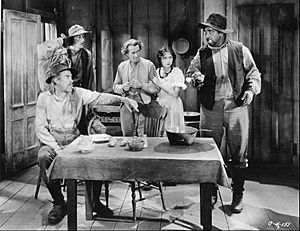
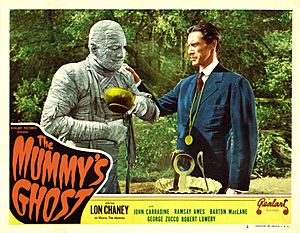
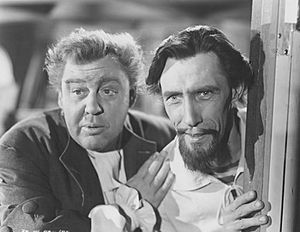
John Carradine's first official film role was in Tol'able David (1930). He later claimed he acted in 70 movies before getting his name in the credits. He also said he tried out for the main roles in Dracula and Frankenstein. While he didn't get those parts, he did play Count Dracula in later films like House of Frankenstein and House of Dracula.
By 1933, he was known as John Peter Richmond. In 1935, he officially started using the stage name "John Carradine." Two years later, he legally changed his name to John Carradine. In 1935's Bride of Frankenstein, he had a small, uncredited role as a hunter.
By 1936, Carradine joined director John Ford's group of actors. He appeared in 11 films with Ford. His most important role with Ford was as Preacher Casy in The Grapes of Wrath (1940). He also appeared in Ford's The Man Who Shot Liberty Valance (1962) and Stagecoach (1939).
He played the Biblical hero Aaron in Cecil B. DeMille's movie The Ten Commandments (1956). He also had a strong role as Reinhard Heydrich in Hitler's Madman (1943).
Carradine loved working on stage. He even had his own Shakespearean company in the 1940s, playing famous roles like Hamlet and Macbeth. He also appeared in many Broadway shows, including The Madwoman of Chaillot and A Funny Thing Happened on the Way to the Forum. He toured in plays like Tobacco Road and Cat on a Hot Tin Roof.
John Carradine claimed to have been in over 450 movies. While only about 225 films are officially recorded, his count is closer to true if TV movies and shows are included. He often played strange, scary, or evil characters, especially in horror films. He sometimes took on heroic roles, like Casy in The Grapes of Wrath. He also played sympathetic characters, such as in Son of Fury: The Story of Benjamin Blake.
He appeared in many low-budget horror films. He often did these movies to earn money for his classical theater company. He also had a small but important role in the expensive comedy The Court Jester. Carradine also made over 100 TV appearances over 39 years. His first TV role was in 1947, playing Ebenezer Scrooge in A Christmas Carol. His last TV role was in 1986 on The Twilight Zone. He appeared on shows like My Friend Flicka, The Munsters, Lost in Space, and Bonanza.
In 1985, Carradine won an Daytime Emmy Award for his role in the special Umbrella Jack. He also did voice work, like the Great Owl in The Secret of NIMH (1982) and the Wizard in Aladdin and the Magic Lamp. One of his last film appearances was in Peggy Sue Got Married (1986). His final film, Jack-O, was released after his death.
Carradine's deep, powerful voice earned him the nickname "The Voice." He was also called the "Bard of the Boulevard" because people said he walked around Hollywood reciting Shakespeare. He always denied doing this.
Family and Final Years
John Carradine was married four times. His first wife was Ardanelle Abigail McCool. They married in 1935 and had two sons, Bruce and David. John adopted Bruce, who was Ardanelle's son from a previous marriage. They divorced in 1944.
In 1945, Carradine married Sonia Sorel. She was also an actress and had appeared with him in the film Bluebeard. John and Sonia had three sons: Christopher, Keith, and Robert. They divorced in 1957.
When John Carradine married Doris (Erving Rich) Grimshaw in 1957, she had two sons from previous relationships. These sons, Dale and Michael, are sometimes also considered part of John Carradine's large family.
John Carradine died in Milan, Italy, on November 27, 1988, at the age of 82. He passed away from heart and kidney failure. His son David was with him in the hospital, reading Shakespeare to him. David said his father's last words were, "Milan: What a beautiful place to die."
Legacy and Acting Family
John Carradine left a big mark on the film industry. In 1960, he received a star on the Hollywood Walk of Fame for his movie work. In 2003, he was honored in the Western Performers Hall of Fame in Oklahoma City.
Four of Carradine's five sons became actors: David, Robert, Keith, and Bruce. David had a very successful career, appearing in many movies and TV shows. His success often helped other family members find work. John and David appeared together in films like The Good Guys and the Bad Guys (1969) and Boxcar Bertha (1972).
John and his sons also appeared together on television. John and his half-brother Robert were in David's TV series Kung Fu. John played the character Reverend Serenity Johnson in three episodes of the show. David's brothers Bruce and Keith also appeared in the series. David, Keith, and Robert had a funny cameo together on the show The Fall Guy, where their father also co-starred.
Robert Carradine appeared with his father in an episode of The Twilight Zone in 1986. In the episode "Still Life", Robert played a photographer, and John played a college professor who helped him.
Television Roles
Here are some of the many TV shows John Carradine appeared in:
- My Friend Irma, CBS comedy (1952–1954) as Mr. Corday
- Cheyenne, TV western (1957) Episode – "Decision at Gunsight" as Delos Gerrard
- The Rifleman, TV western (1959) Episode – "The Photographer" as Abel Goss
- Gunsmoke, TV western (1959) as Kader
- The Twilight Zone (1959) Episode – "The Howling Man" (1960) as Brother Jerome
- Maverick in "Red Dog" (1960) starring Roger Moore, Lee Van Cleef and Sherry Jackson
- The Rebel, TV western (1961) as Elmer Dodson
- The Beverly Hillbillies (1966) Episode - “The Great Jethro” as Marvin Bagby/Marvo the Magnificent
- The Munsters (1964–1966) as Mr. Gateman
- Lost In Space (television series 1965–1968) Episode – "The Galaxy Gift" (April 26, 1967)
- Daughter of the Mind (ABC Movie of the Week 1969) as Bosch (December 9, 1969)
- Night Gallery (episode: "Big Surprise/Quoth the Raven/Prof. Peabody's Last Lecture", 1971)
- Kung Fu (3 episodes: 1972, 1974 and 1975); as Preacher Serenity Johnson, John played opposite his son David, who was the star of the series.
- The Night Strangler (1973) as Llewelyn Crossbinder
- The New Adventures of Wonder Woman (1978) as Harlow Gault
- The Twilight Zone (1985) Episode – "Still Life" (1985) as Professor Stottel
Images for kids
See also
 In Spanish: John Carradine para niños
In Spanish: John Carradine para niños


